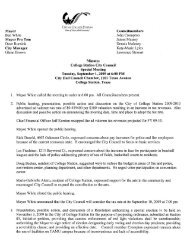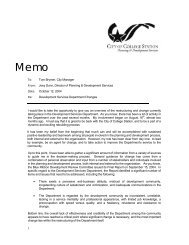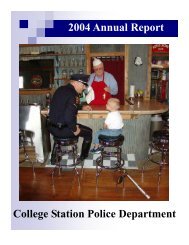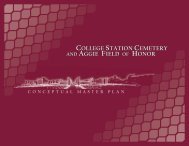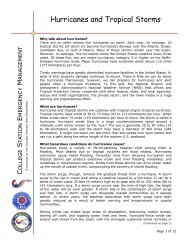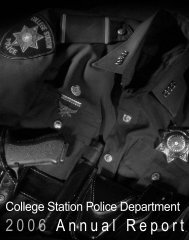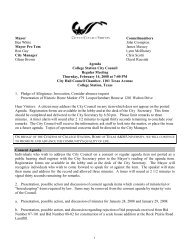The 2005 Hurricane Response After Action Review Presentation
The 2005 Hurricane Response After Action Review Presentation
The 2005 Hurricane Response After Action Review Presentation
You also want an ePaper? Increase the reach of your titles
YUMPU automatically turns print PDFs into web optimized ePapers that Google loves.
College Station<br />
<strong>2005</strong> <strong>Hurricane</strong> <strong>After</strong> <strong>Action</strong> <strong>Review</strong><br />
8 December <strong>2005</strong>
PURPOSE<br />
This report was prepared at the direction of Glenn Brown,<br />
Interim City Manager, and is intended to provide a<br />
comprehensive review of the emergency response efforts of<br />
the City of College Station to the <strong>Hurricane</strong> Katrina and<br />
<strong>Hurricane</strong> Rita evacuations and related incidents. <strong>The</strong> report is<br />
based upon feedback provided by numerous City employees<br />
who were directly or indirectly involved in the various areas of<br />
responsibility during these two extended operations.
Background<br />
<strong>Hurricane</strong> Katrina<br />
Strongest In <strong>The</strong> Last 100 Years<br />
CAT 4 At Landfall<br />
920mb – Third Lowest On Record<br />
500 In 4 Shelters<br />
1700 In Local Hotels<br />
Local Involvement 29 Aug – 12 Sept<br />
500 Family Members Still In <strong>The</strong> Area<br />
<strong>Hurricane</strong> Rita<br />
Winds Out To 150 Miles From Center<br />
CAT 3 At Landfall<br />
937mb At Landfall<br />
9,300 In 32 “Official” Shelters<br />
1700 In Local Hotels<br />
Local Involvement 20 Sept – 28 Sept<br />
3 Million Evacuated the Gulf Coast<br />
2,200 11,000<br />
Both <strong>Hurricane</strong>s Were a Category 5 In <strong>The</strong> Gulf
Findings<br />
Information was obtained through the employee response forms<br />
along with discussions of the review panel. <strong>The</strong>se items were<br />
grouped according to the subject areas as stated in the Brazos<br />
County Emergency Operation Plan. This is intended to provide<br />
a straight forward look at the two responses and identify specific<br />
areas that function well along with those that need<br />
improvement.
Finding Categories<br />
Alert & Warning<br />
Resource Management<br />
Shelters/Mass Care<br />
Direction and Control<br />
Evacuation<br />
Human Services<br />
Law Enforcement<br />
Volunteer Resources<br />
Health/Medical<br />
Transportation<br />
Public Information<br />
Donations Management<br />
Public Works<br />
Over<br />
100<br />
Surveys
Recommendations<br />
To improve our capabilities for future emergency response<br />
efforts, we must learn from the past. <strong>The</strong> key is to<br />
anticipate future events and determine needs to meet<br />
those challenges. Also, it is imperative that mistakes not<br />
be repeated. If we do not provide an honest assessment of<br />
past operations and determine ways to fix problems that<br />
have been identified, we are assured that we will repeat<br />
them. This is not acceptable for our employees or our<br />
citizens.
Short Term Recommendations<br />
Complete by July, 2006<br />
Revise ANNEX C: Shelter & Mass Care<br />
Web EOC Training<br />
Revise Gateway Plan<br />
All agencies National Incident Management System (NIMS) compliant<br />
Designate the creation of the Department of Emergency Management<br />
Complete a proposal for a new County-wide EOC facility
Mid-Term Recommendations<br />
Complete by January, 2007<br />
Conduct Shelter Operations Training<br />
Provide Adequate Staffing for Emergency Management<br />
Repair the Emergency Alert System (EAS) at the Brazos County EOC<br />
Acquire a County-wide AM Low Band radio alert system<br />
Identify the requirements to adapt Web EOC for the Shelter locations<br />
Create, staff and train for a Joint Information Center (JIC)<br />
Acquire additional 800mz radios for emergency management operations<br />
Reconfigure existing 800mz radios to enhance interoperable capabilities<br />
Conduct disaster recovery training for City staff.<br />
Conduct an annual review of emergency plans
Long Term Recommendations<br />
Complete by January, 2009<br />
Develop a new county-wide EOC for all local agencies<br />
<strong>Review</strong> and revise ANNEX E: Evacuation<br />
Continue to "harden" the utility system<br />
With concrete poles,<br />
Underground electric service<br />
Standby generators at essential facilities<br />
Provide on-going maintenance and tree trimming
College Station<br />
Emergency <strong>Response</strong> History<br />
1983 August <strong>Hurricane</strong> Alicia<br />
1991 December Floods<br />
1992 October Floods<br />
1994 October Severe Thunderstorms / Floods<br />
1995 September Encephalitis Mosquito Control<br />
1997 November Bush Presidential Library Dedication<br />
1999 May Seminole LPG Pipeline Rupture<br />
1999 November Aggie Bonfire Collapse<br />
1999 December Y2K Precautions<br />
2000 August Shenandoah Pipeline Rupture<br />
2003 April Region-wide Electric Outage<br />
2003 July West Nile Mosquito Control<br />
2004 May Floods<br />
<strong>2005</strong> August <strong>Hurricane</strong> Katrina<br />
<strong>2005</strong> September <strong>Hurricane</strong> Rita<br />
2006 ???????? ????????????
<strong>After</strong> <strong>Action</strong> <strong>Review</strong><br />
‣ It is not a critique<br />
‣ It is a facilitated professional discussion<br />
‣ It should be a positive learning experience<br />
‣ It is not a “blood letting”<br />
‣ It is not a test; it does not grade success or failure
<strong>After</strong> <strong>Action</strong> <strong>Review</strong> Agenda<br />
1. Report Overview<br />
2. Lincoln Center Lance Jackson<br />
3. Conference Center Grace Calbert<br />
4. Gateway Reception Center Sheila Walker<br />
5. Communications Mike Hare<br />
6. Police Department Operations Chief Clancey<br />
7. Fire Department Operations Chief Alley<br />
8. Public Works Operations Marshall Wallace<br />
9. CS Emergency Operations Center Steve Beachy<br />
10. BC Emergency Operations Center Brian Hilton<br />
11. Comments from attendees All Departments<br />
12. Closing Remarks Glenn Brown



